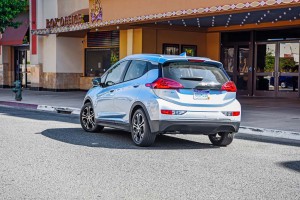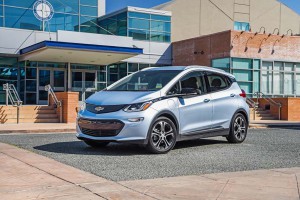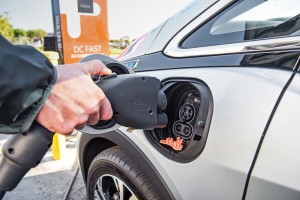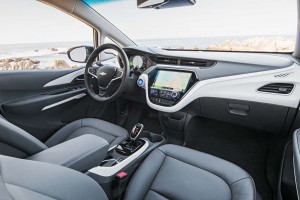The Tesla Model 3 may dominate the headlines, but the new Chevrolet Bolt battery-electric vehicle is meant to beat the Silicon Valley entry at its own game, Chevy today revealing its new model will not only be first into showrooms with an affordable price tag, but that the Bolt will travel at least 30 miles more on a charge.
At 238 miles, the 2017 Chevrolet Bolt will nearly match the distance comparable gasoline-powered hatchbacks can travel on a tank of fuel, though charging times will run longer than a fill-up.
“The Bolt EV is a game changer for the electric car segment and it will start to become available at Chevrolet dealerships later this year,” said GM North America President Alan Batey, who added that Bolt has gone from “vision to a reality … in a few short months.”
That latter comment might be taken as a jab at rival Tesla. The high-profile California automaker unveiled its first mainstream battery-car, the Model 3, on March 31 during a splashy ceremony at its suburban San Francisco factory. That was about three months after Chevy showed off the Bolt during the annual Consumer Electronics Show in Las Vegas. But where Bolt will be on sale before the end of this year, Tesla’s entry won’t reach showrooms until at least the middle of 2017.

The Bolt's rivalry with the Tesla Model 3 continues as Chevy revealed the Bolt goes 30 miles further on charge.
And, even that schedule has drawn plenty of skepticism. Tesla has missed its promised delivery dates with all three of its original products: the Roadster, the Model S and the Model X. The latter, its battery-SUV, fell almost two years behind the mark.
Nonetheless, Tesla’s support remains strong. The company claims to have so far logged more than 400,000 initial deposits for the Model 3. But those are refundable, and it remains to be seen if that will translate into actual sales. The maker’s media-savvy CEO Elon Musk has been so upbeat about the new model that he predicts Tesla’s overall sales should reach 500,000 by 2018. That would be nearly a tenfold increase over its 2015 volume.
Range could be the real game-changer, however. While battery-electric vehicle, or BEV, proponents have insisted that the average American motorist could get by on less than 100 miles a day, studies also show that motorists feel so-called “range anxiety” with the limited capabilities of today’s models. It’s believed that being able to top 200 miles should make motorists feel they’d be prepared to deal with most unexpected occurrences without the risk of being stranded by a dead battery.
Bolt will get 238 miles, according to testing by the EPA. Tesla has said the Model 3 will get 215 miles per charge. Both vehicles would deliver more than a base Tesla Model S, at 210 miles – and do that for a fraction of that sedan’s $66,000 entry price.
(Plug-based cars set for rapid growth, new study says. For more, Click Here.)
Tesla has indicated that it will follow the same pattern it has with the Model S line, however. That would mean buyers could opt for a bigger battery pack, but that would drive the price of the Model 3 into at least $40,000 territory, even after a buyer received the available federal tax credits.
The Tesla Model 3 will come in around $35,000 after the $7,500 federal incentives, the Chevrolet Bolt around $30,000.
In general, electric vehicle range is beginning to climb as suppliers come up with lighter, smaller and more powerful lithium-ion batteries. Tesla, for example, just launched the new Model S P100D which became the first-ever retail BEV to deliver more than 300 miles – 315 to be exact – on a charge. Nissan is expected to push into 200-mile territory with the next-generation Leaf. And Ford, Audi, Mercedes-Benz and others are also looking to get above that figure in the next few years.
What also helps is that automaker are now rethinking the design of their battery-cars. Instead of using conventional designs requiring them to stuff batteries into existing nooks and crannies, both the Chevrolet Bolt and Tesla Model 3 will use skateboard-like platforms that mount the batteries in a thin layer directly below passengers’ feet.
(Click Here to see more about Tesla cracking the 300-mile barrier.)
Chevy, meanwhile, opted for a tall design that maximizes headroom and overall interior space, rather than the sedan layout that Tesla went with.
Despite several advantages over the Model 3, it’s unclear whether the Bolt will get the same level of market response.
But parent General Motors is targeting more than just the retail market, anyway. Pam Fletcher, the project’s chief engineer, told TheDetroitBureau.com earlier this year that the Bolt will be one of several models drivers for the Lyft ride-sharing service will be able to lease at a special, weekly rate. To enhance the appeal for such services, the product development team eliminated the traditional door rocker panels to make it easier for passengers to slide in and out of the vehicle.
(To see more about VW’s plans to produce an affordable 300-mile EV, Click Here.)
Bolt’s longer range could make it appealing to Lyft drivers, sharply reducing their energy costs. The downside is that, according to the EPA, it will still require a 9.3-hour charge on a 240-volt charger once the batteries are fully drained.




Come on – who proof reads this stuff! BOLT not VOLT
Sadly, at 6 AM, someone with very blurry eyes.
I think your title is wrong. Shouldn’t it be “Chevy Bolt”, not “Chevy Volt”?
It should be and is being corrected. Argh
And what is the range with the heater or A/C running full blast in Arizona or Texas? What is the range during the last 25% of the batteries’ life?
Yes, I always wonder what the range is when it’s dusk, 90 degrees, and the stereo is THUMPIN’!